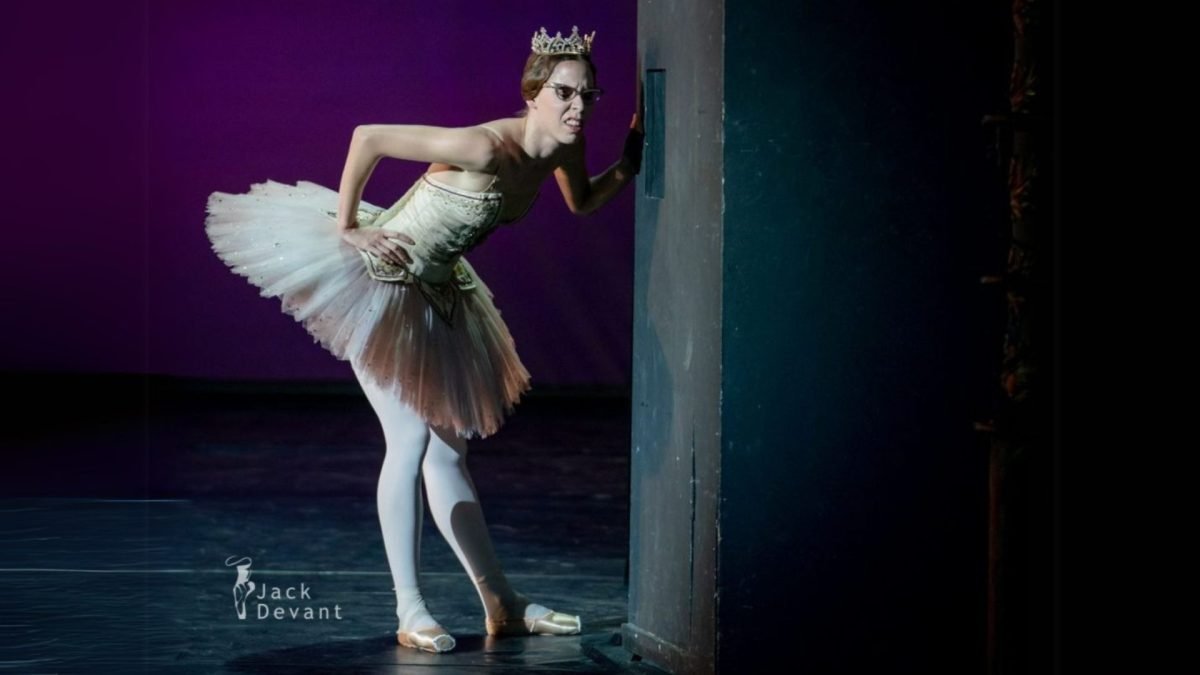By Anagha Madhan and Maya Haridas for En Avant Spring 2025
Ballet has a reputation of being rather solemn and serious. Beautiful, of course, but not exactly light hearted. Well, that isn’t always true! A great many ballets have characters or pieces that make the audience clutch their seats and laugh out loud. While these are highly appreciated while watching a ballet, we don’t discuss them enough or give them the love that they deserve! So here are our favourite bits of comedy on stage that we’d love to share with you!
Bottom the Donkey (Midsummer Night’s Dream)
Bottom the Donkey from A Midsummer Night’s Dream is one of the most hilarious, endearing characters in this magical ballet, and arguably, in all of ballet. Transformed into a donkey by the mischievous Puck, Bottom becomes the involuntary centre of the chaos of comedy in the enchanted forest. His character shows a mix of confidence and cluelessness, and every moment on stage is delightful – from his exaggerated prancing to his proud braying, he is fully embracing his new form. His crowning comedic moment is his bizarre but strangely sweet pas de deux with Titania, the fairy queen, under a love spell. Watching Bottom preen in her affections, completely oblivious of the absurd nature of his predicament, never fails to bring the audience down with laughter! Watch Bottom’s pas de deux here, as performed by The Nationale Opera & Ballet!
Step sisters (Cinderella)
The Stepsisters in Cinderella are a comedic triumph, and are often portrayed by men in drag, adding an extra layer of hilarity to their already over-exaggerated antics. These characters revel in their over-the-top awkwardness, with excessive gestures and clumsy attempts to appear refined, making them a hilarious contrast to Cinderella’s quiet elegance. Their antics at the royal ball are especially hilarious as they stumble through their dances, tripping over their lavish costumes, and squabbling in a bid for the Prince’s attention. Their absurd portrayal, complete with oversized wigs, exaggerated makeup, and comedic timing, makes every scene with the stepsisters into a laugh-out-loud spectacle, solidifying the stepsisters as some of ballet’s most beloved comic characters. Here are Ellen Ross and Lizzy Powell of the San Francisco Ballet talking us through their experience playing the two stepsisters!
Dr Coppelius (Coppelia)
Dr. Coppelius in Coppelia is essentially the perfect representation of a comedic villain, eccentric and utterly captivating. He is often portrayed with a flair of physical comedy – the bumbling, genius inventor is hilariously oblivious to the chaos he causes. Obsessed with bringing Coppelia, his life sized doll, to life, he becomes a source of laughter as he fusses about, mutters, and grandly gestures around his cluttered workshop. The highlights of his hilarity come when Swalinda, disguised as Coppelia, tricks him into thinking his creation has come to life. Dr. Coppelius’ astonishment and delighted confusion, along with his theatrical attempts to ‘improve’ his scientific methods, make him a lovable figure at the end of the day, adding a delightful charm to the ballet. Watch the scene from the IInd act of the ballet here, as put up by Marharyta Cheromukhina and Milan Rus in the National Theatre of Berlin!
Sancho & Gamache (Don Quixote)
Sancho Panza and Gamache in Don Quixote are a comedic duo that bring humour into the otherwise fiery ballet. Sancho, who is Don Quixote’s loyal yet bumbling squire, is a tornado of mischief and clumsiness, often getting himself into scrapes that leave the audience laughing. Whether he is being chased or hoisted, his physical comedy makes him extremely endearing. Gamache on the other hand, is the pompous, overdressed rake vying for Kitri’s hand, his flamboyant arrogance matched by his absolute ineptitude. The interactions of such characters have only one possible result – comedic gold. Gamache’s exaggerated swagger clashing with Sancho’s chaotic antics, they create a perfect storm of hilarity, adding a layer of silliness to this passionate ballet.
Watch a snippet of Sancho and Gamache’s antics in the Act I Finale here:
Widow Simone (La Fille Mal Gardee)
La Fille Mal Gardée translates to The Badly Guarded Daughter, or The Wayward Daughter and is full to the brim with characters that make one laugh (there’s a rooster and chickens and a hapless suitor). The comic star though, is Widow Simone (played in our expert by Will Tuckett of the Royal Ballet). We see her struggle as she tries to force her daughter Lise (who knows exactly what she wants and is afraid to go for it) to marry the hapless suitor. One of Simone’s most entertaining moments is the clog dance, where she decides to have fun for once, hitches up her skirts and joins in a spirited dance with Lise’s friends!
The Queen of Hearts (Alice in Wonderland)
The wickedly delightful character from Christopher Wheeldon’s ballet takes a dancer with both fantastic acting chops and ballet technique to do justice to it. Watch the Royal Ballet’s Zenaida Yanowsky perform the Tart Adage – a parody on one of classical ballets crown jewels, the Rose Adagio from Sleeping Beauty. While Princess Aurora is presented with roses by her admiring suitors, in this version the Queen of Hearts is presented with sticky jam tarts by four flunkies who are forced to dance with her (if they don’t, then off with their heads!)
Want to find out Zenaida Yanowsky’s process for becoming this hilarious villain? Watch this video to hear from her, Christopher Wheeldon on his vision for the role, and other members of the cast on dancing alongside this madcap of a character!
The Mistake Waltz (The Pacific Northwest Ballet)
Jerome Robbins’s comic masterpiece channels the inner chaos and confusion (while still trying to keep it together externally) that comes with messing up on stage. The Mistake Waltz is a ballet recital gone wrong and it is sure to resonate with every dancer! From standing in the wrong place, to being out of time with the music. From bumping into someone to running off stage early (and doing most of it thinking you are right and it’s everyone else that’s making the mistake). What is really interesting to note, is that each of these mistakes has been choreographed to perfection. For example, in the section where they all mess up the timing (1:30 to 2:07 in the video) each dancer has a specific pattern and set of counts to follow to make it look like chaos!
Le Grand Pas de Deux
Christian Spuck’s fantastically funny pas de deux is a treat to watch, performed here by Lauren Cuthbertson and Alexander Jones as an interlude during the Prix De Lausanne competition. Our two protagonists take us through complex choreography (featuring snippets from ballet’s most revered pas de deuxes) all the while being hilarious themselves. Lauren’s character is delighted to be on stage (though a trifle befuddled) and obstinately attached to her handbag. Alexander’s character is trying his utmost to put on a good show while trying to deal with (and sometimes getting exasperated by) his partner’s shenanigans.
If you’d like a deeper look at the piece (and a chance to guess the famous repertoire featured in the piece) then you can watch this super fun commentary for the Le Grand Pas De Deux by Jordan and Eden from Ballet Reign!
Cacti – Pacific Northwest Ballet
Watch excerpts from Alexander Ekman’s Cacti – a satirical look at the world of contemporary dance and art criticism.
Ekman has written: “This work is about how we observe art and how we often feel the need to analyze and ‘understand’ art. I believe that there is no right way and that everyone can interpret and experience art the way they want. Perhaps it’s just a feeling that you can’t explain or perhaps it’s very obvious what the message is.”
“Cacti was created during a period of my life where I was very confused and upset every time someone would write about my work. I did not find it fair that one person was going to sit there and sort of decide for everyone what the work was about. I have stopped reading my reviews, but still question this unfair system mankind has created.”
The piece starts off with an audio of a long winded, pseudointellectual ‘review’ of this new work. Then the audience (who has heard what the piece is supposed to mean) is shown the piece, while getting to listen to the dancers’ conversations (and random thoughts) while they dance. They try to remember what’s next, worry about dropping each other, and negotiate the terms of a breakup.
The dancers are trapped on scrabble-like blocks for much of the piece and then they each acquire a cactus. Make of it what you will!
Here are two excerpts from the Pacific Northwest Ballet’s production of Cacti, and an interview with Alexander Ekman and the Sydney Dance Company.








Leave a Reply